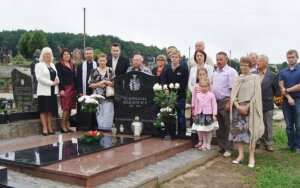- August 12, 2014
- 614
“Not everything that death touches dies.” Family reunion of Rodowicz and Radavičius

In Žemaitija, on August 9, 2014 was held the reunion of Radaviczius family. Family Radaviczius earlier Rodowicz is known in Žemaitija from the end of the fifteenth century.
The initiator and organizer of the family ceremony was Zilvinas Radaviczius – known social activist and lover of Polish culture. He spends all his free time documenting the facts important for the culture of Polish-Lithuanian Commonwealth, concerning the activities of noble families.
The ceremony was attended by: the historian and educator Edvardas Dirmeikis from Kražiai, Director of the Museum at the MK Sarbiewiusz Cultural Centre in Kražiai – Vygantas Mażonas, pastor of the church in Kražiai, Vytautas Ripinskis, Bronius Tamoszaitis – author of the monument, Joanna Rodowicz – painter, who the last week at the invitation of house of Polish Culture in Vilnius led art workshops.
Family feast was inspired by the tradition and heritage of nobility, and the immediate cause was the 30th anniversary of the death of Władysław Radaviczius – grandfather of Zilvinas.
Founded by the grandson, a beautiful tombstone of granite slabs made a great impression not only on family members. On the monument, in addition to the name and dates is carved family crest – Rudnica, and the words “Not everything that death touches dies.”
In the church in Kražiai the mass was held in the intention of Radaviczius family and Rodowicz family, after which all went to the cemetery to witness the blessing of the grave of Wladyslaw Radavicziusa.
Zilvinas talked about his grandfather who lived before the war in Lithuania. He had to work hard to support his wife and six sons. Still in the days of Soviet power, he gave Żilvinas wooden cross, decorative, historic spirit level and a coin from the time of Hitler with pierced swastika.
Revealing the monument, he remembered that his grandfather always was interested in the construction and the grave is a building complex in tribute to him.
Zilvinas thanked his cousin Albina Żeringiene for taking care of the grave of his grandfather Władysław for the last 30 years.
Not forgotten were graves of cousin Stanisława Żukauskiene and Bolesław and Rosalie ( Głazowscy) and Rodowicz, where they paid a tribute and prayed.
Boleslaw took part in the defense of the Church in Kražiai against the Cossacks on November 22, 1893, during this heroic struggle he was beaten and lost an eye.
In Museum of Kražiai, the manager of Museum – Vygantas Mażonas – told us about the history of Kražiai, Lithuanian notes, Collegiate of Kražiai and historical figures. He showed casemates where the Cossacks tormented defenders of the church in Kražiai.
The museum exhibition on the defense of the church is Kražiai includes the image of Boleslaw. At the exposed photo Zilvinas Radaviczius, great-grandson of Boleslaw said that we find heroes in our families everywhere, because they are guided by a deep Catholic faith and great patriotism. At The Warsaw Uprising Museum he saw the exhibition showing Janek Rodowicz nickname Anode – the hero of World War II and the Warsaw Uprising. Here in Kražiai is another beautiful figure of family: Boleslaw.
During this period, Boleslaw lived with his family in a rented assets in Bragowiszki. The nobility of the Catholic faith at that time caused a great obstacle to the acquisition of the ownership of any property. From Bragowiszki he went to defend the church.
Our families who have the inspiration, and youth and the next generation will know that their ancestors had a strong foundation built by Catholic faith and love for the homeland.
Family meeting ended in a picturesque location – at the farmstead of Stanislaw and Anna Radaviczius (oldest members of the family) run together with her daughter Genute and her husband Pranas Pałubiński.
Hospitality of the hosts encouraged discussions on the future plans.
Żylvinas – the originator together with his cousin Wladyslaw proposed renovation of the tomb of Boleslaw – the defender of church in Kražiai.
Everyone enthusiastically obliged to participate in this endeavor.
It is a remarkable example of joint action, combining the family, and would be even more wonderful if entire nations were concerned.
Translated by Patrycja Pawłowska within the framework of a traineeship programme of the European Foundation of Human Rights, www.efhr.eu.

